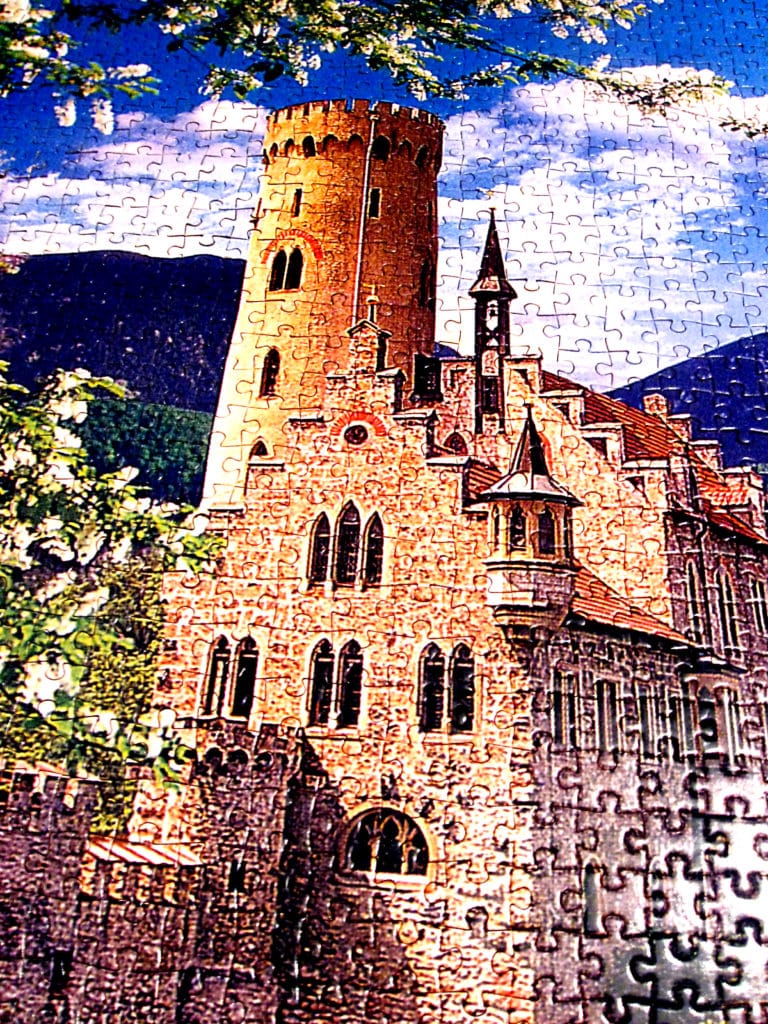Last Updated on February 14, 2024 by JigsawPuzzleGuru
A jigsaw puzzle is a tiling puzzle that requires connecting strangely shaped interlocking and mosaic pieces. Typically, each piece contains a tiny bit of a bigger picture; when put together, the details make up a complete picture.

In the 18th century, jigsaw puzzles were designed by painting a picture on a flat, rectangular wood piece, then separating it into smaller pieces. Despite the name, a jigsaw was never used during production. John Spilsbury a cartographer, and engraver from London is accredited to introducing jigsaw puzzles worldwide around 1760. Since then, they have come to be crafted mainly of cardboard.
Usual images on jigsaw puzzles include scenery from nature, buildings, and repetitive patterns—waterfalls and mountains are common and other common subjects. However, any picture can be used. Worldwide, puzzle-makers and companies use technologies for a one-off small print-run puzzle to showcase a massive variety of puzzle subjects, such as optical illusions, surreal art, and personal portraits. In addition to the traditional flat, two-dimensional puzzles, 3D puzzles have entered large-scale production. You can even encounter some spherical puzzles and architectural recreations on the market.
Many jigsaw puzzle accessories like boards, frames, cases, and roll-up mats have become available to assist jigsaw puzzle enthusiasts in the last decades.
While most finished puzzles are disassembled to reuse again, they can also be attached to a backing with adhesive and displayed as art pieces.
History of the Jigsaw Puzzle
London engraver and cartographer John Spilsbury has created the first jigsaw puzzle around 1760, using a marquetry saw. He started a trend in which early puzzles, known as dissections, were produced by mounting maps on hardwood sheets and cutting along national boundaries. Some of the first jigsaw puzzles were created to help to teach geography. Royal governess Lady Charlotte Finch used such “dissected maps” to teach the children of King George III and Queen Charlotte.
The name “jigsaw” came to be associated with the puzzle around 1880 when fretsaws became the preferred tool for cutting shapes. Since fretsaws are different from jigsaws, the name appears to be a misnomer. Then in the late 1800s, the first cardboard jigsaw puzzles appeared but were slow to replace wooden ones because manufacturers felt that cardboard puzzles would look low-quality and profit margins on wooden jigsaws were more significant.
Jigsaw puzzles rose in popularity during the Great Depression, as they offered a cheap, long-lasting, recyclable form of entertainment. It was around this time that jigsaws grew to become more complex and more attractive to adults. They were also given away in product promotions and used in advertising, with customers completing an image of the promoted product.
Sales of wooden jigsaw puzzles decreased after World War II because the newly improved wages led to price increases, while improvements in manufacturing processes made paperboard jigsaws more attractive.
According to the Alzheimer Society of Canada, doing jigsaw puzzles is one of many activities that can help keep the brain active and reduce the risk of Alzheimer’s disease. Nowadays, jigsaw puzzles serve as one of the most popular brain training methods for patients with neurological disorders.
Modern Construction
Most modern jigsaw puzzles are made of cardboard as they are easier and cheaper to mass-produce. An enlarged photograph or printed reproduction of a painting or other two-dimensional artwork is glued to cardboard, then fed into a press. The press forces a set of hardened steel blades, called a puzzle die, through the board until it is fully cut.
The puzzle die is a flat board, often made from plywood, with slots cut or burned in the same shape as the used knives. The knives are set into the spaces and covered in a compressible material, typically foam rubber, which ejects the cut puzzle pieces.
The cutting process is not unlike using a cookie cutter to shape cookies. However, the forces involved are tremendously greater: A typical 1000-piece puzzle requires upwards of 700 tons of power to push the die through the board.
New technology allows for laser-cutting of wooden or acrylic jigsaw puzzles. This offers the ability to custom-cut to any size or shape puzzle, with any variety of number and size of pieces. Many museums have laser-cut acrylic puzzles made of some of their art, so visiting children can assemble puzzles of the images on display. Acrylic pieces are very tough withstanding continued use without the image being damaged. Also, because the print and cut patterns are computer-based, missing pieces can easily be remade.
Photo by Alvimann at Morguefile.com


